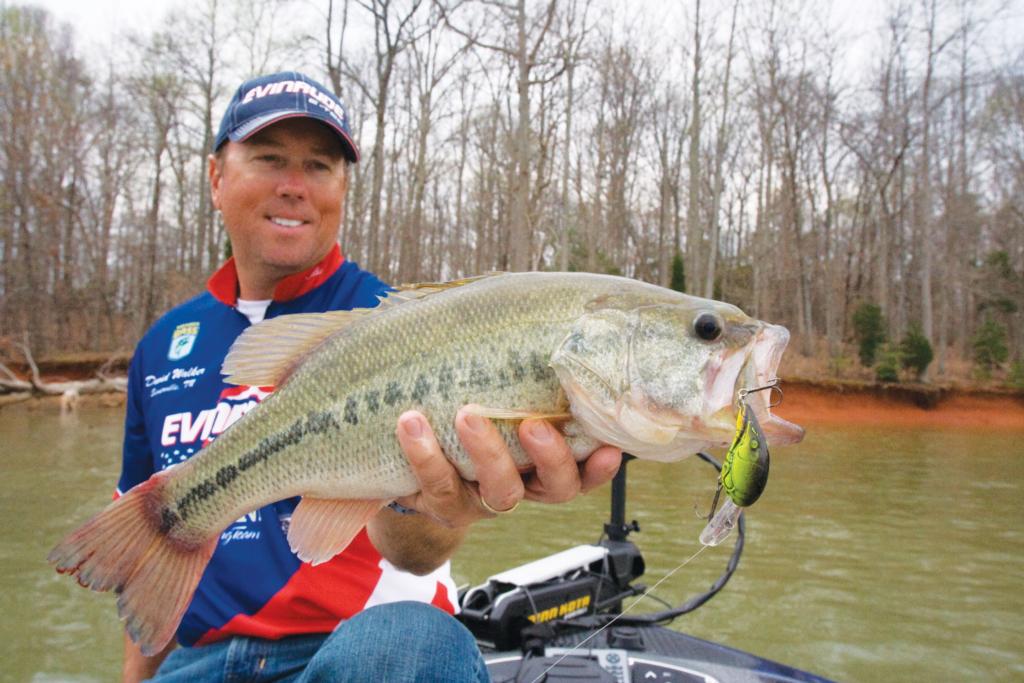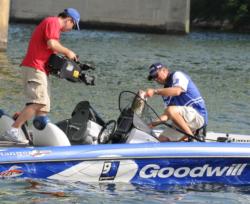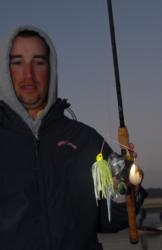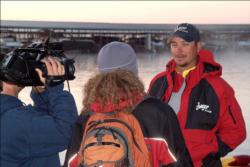Trials & tributaries
Escape the slow dog days of summer in a lake by making a run upriver

————————————–
Editor’s note: This is just one article from a recent issue of FLW Outdoors Magazine, which publishes both a Bass Edition and a Walleye Edition. To learn more about the magazine and how to subscribe, click here.
————————————–
It’s 9 a.m., and the thermometer is already pushing 90 degrees. You slide on your sunglasses because the big fireball in the sky has climbed high enough into the humid air to warrant shade. Immediately, the first sweat of the day forms on your brow and streaks down the inside of your sunglasses.
The schooling spot you started on at daylight produced three nonkeepers. And so far the second schooling spot has yielded nothing.
You scan the lake’s mirror-flat surface for any hint of activity; nada. That sick feeling begins to creep into your gut; your inner voice whispers to you that the last bite of the day has already occurred. As you look down, a bead of sweat drips off your nose and lands on the reel. From there, it slowly snakes and winds its way down the side plate and over your hand, leaving a streak of moisture in its path that looks almost like …
A river.
Like all upland impoundments, the deep, clear lake beneath your boat is fed by a river, far upstream. And even during the hottest day of summer, that river offers salvation for bass anglers.
With renewed enthusiasm, you reel in, fasten down the rods and set a course, one that takes you on a long trip upstream.
Sure enough, after a refreshing boat ride you discover the bass are waiting in the riverine section of the lake and as eager to bite as you are to catch them.
River-run qualifications
Bass fishing from mid- to late summer can be decent on natural lakes or lowland impoundments. But match yourself against a traditional upland or highland impoundment in July or August and it’s often a different story.
Even on the best reservoirs in America, bass seem to vanish when the temperature reaches its average summer peak. For whatever reason – stratification, thermoclines, low oxygen, roaming baitfish – bass in the main lake are difficult to find. One tactic bass pros use to survive the dog-day doldrums on stratified impoundments is to fish the lake’s source tributaries.
However, before running to the rivers, it’s important to know what reservoirs are best tackled in such a way. According to Evinrude pro David Walker of Sevierville, Tenn., these are bare-bank, low-flow impoundments. There might be decent fishing in the rivers associated with many grass-filled reservoirs, but the immense quantities of vegetation mean that there are probably better and closer fishing options in the main lake.

“Running way up a river or creek arm is better for classic impoundments that are big on the lower end and shimmy down into one or two main feeder tributaries up at the top,” Walker says.
Another thing that prompts pros such as Ott Defoe of Knoxville, Tenn., to make a river run is a main-lake thermocline. Many reservoirs, especially those that are part of the Tennessee River such as Kentucky Lake, have enough current running through them so that a thermocline never develops. However, it’s the exact opposite for upland impoundments. The lack of current causes severe oxygen deficiencies at deeper depths. Eventually, as the surface water temperature rises, the water stratifies in the lower end and a significant thermocline develops. Good examples of these classic impoundments include Kerr Reservoir, Clarks Hill Lake, West Point Lake, Lake Martin, Table Rock Lake or Grand Lake.
“Once a thermocline sets in, it seems like those fish in the lower end of an impoundment become very nomadic, chasing shad schools across open water,” Defoe says. “Most of the deeper cover they would like to use is now below the thermocline, so they just roam around with no home.”
Fish in such impoundments might actually feed more at night during the summer and become inactive during the day, suspending over deep water and relating to nothing in particular. With no set pattern for where the fish could be, anglers often sit on “schooling holes” – areas associated with surface schooling activity. The problem with that, as was illustrated in the beginning, is that if the fish don’t show themselves, you’re lost.
One other thing that makes running up the river a viable option is having multiple rivers to choose from. Impoundments such as Kerr Reservoir, Lake Hartwell, Lake Murray and Lake Lanier all have two main rivers coming into them. Plus, the rivers have major creeks in them.
“Anytime there are two main rivers with major creeks forking off those rivers,” Walker says, “it provides plenty of opportunities to find river fish.”
The three Cs
The problem with rivers, however, is they can be huge. Many river systems funneling into large impoundments can be 20 to 40 miles long before they end at the next dam upstream, or end in a shallow, shoal-filled run. If there is a secondary river arm, the number of river miles can double.
So how do pros break down a river? The three Cs: current, color and cooler water.
Of those three, current is the most critical element. Where there is current in a river, the other two Cs come into play big time.
“Dead, stagnant water up in a river in the summer is bad,” Defoe says. “But it only takes a tiny bit of current to attract bass to an area.”
While any current is good because it oxygenates the water and tends to position forage, finding places in rivers where the current velocity changes can be even better. Obviously, eddies or deep bends where current is slowed up are key places, but just as important are places where the current picks up velocity due to the river’s geology.
“Anywhere a river gets narrower, shallower, or better yet, both, the water is forced to move a little faster,” Defoe says. “Once again, it might be a subtle pickup in current, barely detectable, but believe me the bass know it, and they’ll hang out there, especially in times of sluggish current or little water movement.”
However, current is not always obvious in the rivers connected to these reservoirs, especially in the summertime. Watching the surface of the water for boils, eddies or other signs of moving water is still the easiest way to find current in summer. But the two other Cs may hold the keys to better river areas.
Often, where current meets stagnant water there is a change in water color. The color change can go either way, depending on the lake. A bit more stain in water that otherwise is usually clear might indicate the effects of a recent rain. Conversely, clearer water knifing through stagnant, pea-green water often denotes a fresh inflow.
Meanwhile, current cools water to more comfortable temperatures. That’s why it pays to keep a watchful eye on a temperature gauge.

“When poking around in rivers and in the backs of tributaries, pay close attention to your water temperature gauge and the color of the water,” Defoe says. “Anytime you see a 2- to 5-degree drop in water temperature combined with a water-color change, chances are current or some kind of fresh incoming water is present. That’s a good thing.”
Finding the activity zone
Knowing what to look for in a river isn’t always as easy as it seems, and that’s not just because of the vast quantities of water. Sometimes finding current, color and cooler water requires going as far as possible up a river or creek, to the point where obstacles such as sandbars, rocks, stumps or logs are encountered.
Almost every river fanatic has harrowing tales of jumping sandbars, burning flats and idling over stumps for miles to reach an untapped area with fresh current.
“Sometimes getting over shallow obstacles is just part of the game,” Defoe says. “The good news is we’re talking summer here, so it’s no problem to hop out of the boat and wade around to find the best way in or out of a place.”
Walker, too, does his fair share of sandbar hopping, but fishing in rivers does not always have to be that way. Isolating small sections of the river that are “turned on” is the most successful for him.
“There will be a 1- to 2-mile section in 30 miles of river that is drastically different,” Walker says. “The cover is not any different, it’s just that everything is alive. You’ll see herons all over the banks and ospreys diving. There will be shad flicking everywhere and bluegills all up around the shallow-water cover. When you see those clues, bass are nearby.
“And what is amazing is you can go above or below that activity zone and it’s dead – all you’ll see are turtles and gar. But in that one section, it will be like Mutual of Omaha’s Wild Kingdom.”
FLW Tour pro Jason Christie of Park Hill, Okla., has also observed this phenomenon in main tributaries, especially in large creeks. He believes it has to do with shad migrations.
“I’ve been in creeks that were six or seven miles long where everything looks awesome,” Christie says. “And I’ll fish for hours without a bite – not a sign of life. I’ll keep working up the creek and then find a place where it’s solid shad, bank to bank, for several hundred yards, and it’s like everything that swims in the creek is in that little section of water. All I can figure is that shad migrate up and down creeks and rivers, and everything else follows them.”
While Defoe doesn’t dispute the idea of migrating shad, he also adds in that it’s around July, August and September – the same time bass in the main lake disappear – that the young-of-the-year shad are finally reaching eating size in the impoundments.
Of course, with all that bait in the water, the hot temperatures and the clear water, river fishing is seldom gangbusters. The lure selection is simple – an assortment of crankbaits, buzzbaits, jigs and tubes is really all an angler needs – but a typical day still might be a three- to six-bite-a-day proposition. Of course, that’s still better than zero bites in the main lake. Plus, those few bites come up huge in summer tournaments.
“If you catch four or five bass for 9 or 10 pounds on a clearwater impoundment in the middle of August, that’s usually good,” Walker says. “Plus, the river offers the best chance at a big fish that time of year – a 4- or 5-pounder. Add one of those to your 9 or 10 pounds and you’ll be a genius in the dog days of summer.”
 Deep thoughts about shallow fish
Deep thoughts about shallow fish
FLW Tour pro Jason Christie of Park Hill, Okla., offers some interesting observations about the differences between bass in the riverine sections of impoundments and bass in the open lake portions.
Essentially, he sees the two as completely different classes of bass with dissimilar habits.
“Bass in the lower lake of an impoundment are more `social,’ so to speak,” Christie says. “They do everything together as a school. They relate to each other almost more than they relate to cover. They move at the same time; they feed at the same time. When you find a group of main-lake fish that is moved up and feeding in the spring or early summer, nothing can beat it. However, in late summer they become like ghosts.
“River fish, however, are loners. They live shallow and relate to cover. River fish are territorial, defensive and don’t want 15 other bass living on their logs. So catching river bass takes a little bit different mentality. Seldom is river fishing fast and furious – it’s more of a `one here, one there’ kind of deal.”